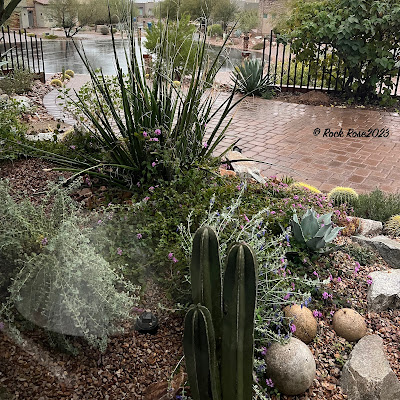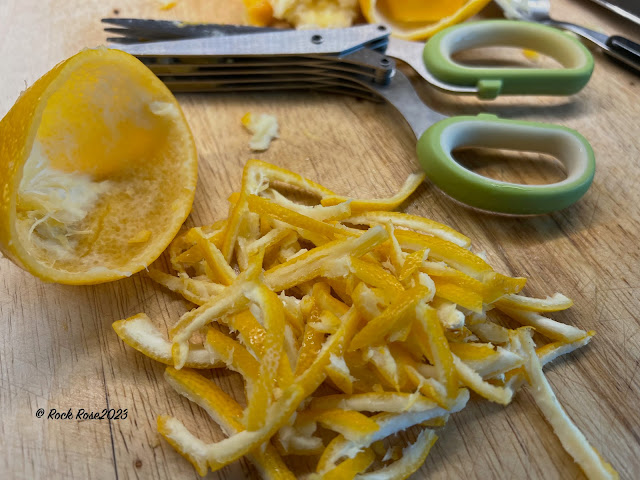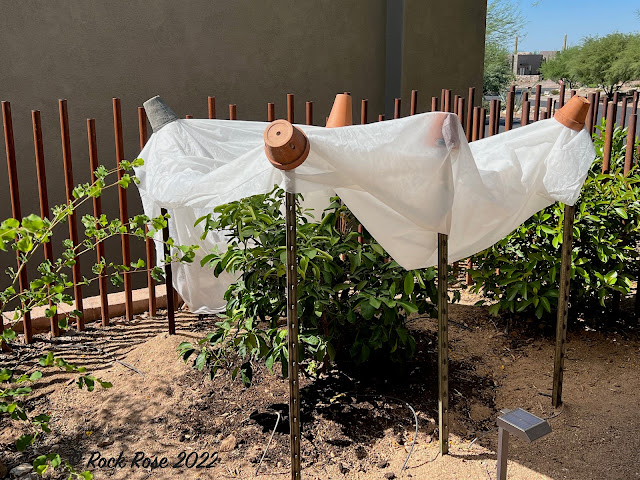What started out as a story at 9 months then 10 and 11 and finally...... we are here in the New Year and a month past the anniversary of the day we moved into the house in Oro Valley, Arizona. I think I may have asked David whether he wanted to carry me over the threshold. He declined.

I was about to get a few hard lessons on desert gardening. But, they have not deterred me from trying to make the small garden areas around the house more to my liking. You may wonder if the summer heat stopped all outside work. That was not the case, although all outdoor work must be done before 10am. It was a small window. Even so the summer has been quite a surprise and much cooler than expected. (We were gone for 3 weeks when we drove up to Wisconsin to attend the Madison Fling). Elevation undoubtedly makes a difference, we are at 3000'. Just when the desert started to take on a dry dusty beige look, the monsoon rains arrived. The days and nights were cooler and the desert became green and bloomed again.
But during this time there was much to observe and learn.
POTS IN THE DESERT
The lace cactus and paddles went into the ground in the early spring. They seem at home.
In Austin I had many cactus in clay pots. There they were happy to spend the summer out in the garden where they had afternoon shade and the winter in the greenhouse or potting shed. Not here. Very few of them can tolerate the summer sun in Arizona, even the morning sun, and being in a clay pots makes them doubly susceptible to a slow death, their roots dried and fried. That Austin 'death star', bears no resemblance to the fierce sun that shines down on my small garden. All my potted plants are hungry for shade. A few are in temporary places under trees but they will either find a home in the ground or go to The Little Free Garden Stands. I aimed to have dealt with them before winter arrives. (It did not happen). Many have succumbed and I have boxes of empty pots in the garage. And one thing I didn't have in Austin was critters who like to eat succulents although the birds did peck them from time to time. Some of my prettiest plants have been nibbled mercilessly. One of the miniature prickly pears was eaten down to nub overnight. The tops of some succulents just eaten off. They were so shocked they didn't produce any blooms this year. They just got busy repairing the damage.

This plant started to close up the wound and began making a new baby.
And now has a chubby little offspring.
There is no counting the times I moved pots around. Firstly settling them along the north wall of the house which had complete shade.
But not for long as the sun moved across the back of the house to its final summer solstice location. That shady area was now in full sun for a good part of the day. Now they moved to the east facing patio. A better location for the summer but only if the solar screen was down. With insufficient large pots the numbers of successful potted plants dwindled. This photo is a good reminder of exactly what I have lost since the spring.
CRITTERS
Almost all pots have to be elevated to prevent the pack-rat snacking. The one disadvantage of living right on the edge of the desert. There is little hope of stopping them. The pest people put out traps with bait but they ate it and pooped all around the edges of the wall. I regretted having left 3 Havahart traps at our last house and had to buy another one. The snacking I could stop but I could not tolerate the rat poop. We showed no mercy. A few staddle stones would be in order( look at those on line prices for genuine antique staddle stones) or I could make my own with upturned pots or any other supports that will hold a pot. The challenge is to make the scene look attractive. Another answer is to put the smaller succulents inside a large planter. Or find a place to hang on the wall. Call me fussy but from a design point of view these pots just don't go with the style and color of the house. It would be a good place to have a cactus theater. Unfortunately I don't think we have the equipment anymore to make one.


The Euphorbias are a pretty safe bet. I thought the huernias would be safe too, placing them on the ground, but the flower on one was taken during the night before they began snacking on the ends. Not my favorite way to prune. The two pots are now safely on the wall.
A complete pot of paddle plants was decimated but ones I planted in the ground have so far been left alone. Those rats prefer to run along the edge of walls.
The agave, A. desmettiana variegata and A. demettiana Joe Hoak found a home in in the ground in the shelter of our overhead patio. This and the fact that they don't get any rain may also protect them from low temperatures in the winter. We are more susceptible to winter frost at 3000' Unfortunately pups growing at the base are perfect for the rats to nibble and they did.
The barrel cactus I had in pots have all been planted among barrels that were already here. They seem happy. Damianita is a great companion plant and has been highly successful with almost continuous flower.
One planter that will probably remain has the only squid agave that I brought from my old garden. So far no pups but it has had a happy summer on its pedestal.
We recently found a home in the garden for the potted Meyer lemon tree. It involved taking out a photinia -why did they plant so many- and digging a large hole. The bigger job was getting the plant out of the pot and getting it settled. Then creating a shade structure to help it through the summer. Fingers crossed that it will settle in and bear fruit next year. It has not taken well to the conditions here and even though it bloomed twice it never set fruit.
The lime tree will remain in a pot as it is the least hardy of the citrus. It bloomed twice and only began to set fruit in the fall. Now, in January it is blooming once more and looking as healthy as ever.
The grapefruit, planted a year ago seems to have settled in. It is looking a little yellow from the cold but soon it will be time to fertilize and hope for a crop this year.
It doesn't stop us from looking enviously, over garden walls, at trees laden with fruit but ignored. They are probably at least 15 years old.
AGAVE REMOVAL
The A. weberi looked pretty impressive on first glance. Some of them were about the size of the ones I had had in Austin before the devastating winter event of 2021, but I knew well that they didn't have many more years left. A decision was made to remove the ones in the front bed and one down the side of the house which was planted too close to the path.

David undertook the job of removing them. One thing I had noticed was how few pups there were, once again remembering my Austin agave. A few months later we were to find out why. The agave weevil had been at work removing most of them and now moved on to some of the larger ones. In fact a message went out in the neighborhood that someone had lost his A. ovatifolia to the dreaded weevil. One of the telltale early signs is rat and rock squirrel activity going after the grubs in the base. Although I had experienced weevils in smaller agave in Austin there were usually only one or two. This time there was an infestation of grubs. In all we took out 10 agave. The bonus was a space to plant the lemon tree and a pomegranate.
THE PALO VERDE

Oh! how we enjoyed the blooming of the palo verde tree. We learnt ours was a hybrid "desert museum' Thornless, upright and less messy than the native variety. We remarked on the sound of bees as it bloomed not once but several times after a rain event. I was cleaning the rocks along the side of the driveway when I came across a root that had been severed as it tunneled under the paving. Several pavers had lifted. That was when I put two and two together and came up with the cause of the blocked sewer line we had shortly after moving in. Tree roots had invaded the line which runs down the driveway. The tree still stands but has been pruned heavily, several roots going under the driveway removed and reluctantly we will take it down in the New Year. How they could possibly have thought of planting this tree so close to the sewer lines just shows the thoughtless planting of the landscaper. I have already planted a replacement, a desert willow, further away. It is small but I am told it is a fast grower. It was one of the 3 trees I ordered from our electric company along with the another desert willow and a pomegranate. They offer the following selection of trees from which I have ordered 3 more.

I have some space along the driveway and between our and our neighbor's property. Yesterday, David took out a Texas Olive which was planted far too close to an Anacacho orchid tree. It has exposed the neighbors electric meters but I will plant some evergreen bushes to shield them. The removal of the olive means one less tree to keep pruning and less fruit to dispose of. I have at lest 6 more that may be for the chop.
THE SUN
I was aware of the sun's movement across our garden in Austin but it never seemed to cause much of a problem. Suddenly plants that were shade by the patio in summer we’re exposed to the lower travel of winter sun. I have yet to have full understanding of what will work well under such exacting conditions. But so far I have had success with white alyssum, damianita, Chrysactinia mexicana, dahlbery daisy, Thermophylla tenuiloba, purple skullcap, S. suffrutescens, Gold coin daisy, Asteriscus maritimus, blackfoot daisy, Melampodium leucanthum, chocolate flower, Berlandiera lyrata. All made it through the summer. Some may be short lived.
White alyssum. A survivor.
All the shrubs I planted have survived and some are coming into bloom. We had generous rain over Christmas so I'm looking forward to the wildflowers I planted showing their faces soon.
Happy New Year everyone. Rock Rose is back in the garden with renewed energy.



























.jpeg)























